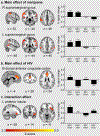Synergistic effects of marijuana abuse and HIV infection on neural activation during a cognitive interference task
- PMID: 30239074
- PMCID: PMC6713620
- DOI: 10.1111/adb.12678
Synergistic effects of marijuana abuse and HIV infection on neural activation during a cognitive interference task
Abstract
Marijuana use, which is disproportionately prevalent among human immunodeficiency virus (HIV)-infected persons, can alter activity in fronto-parietal regions during cognitively demanding tasks. While HIV is also associated with altered neural activation, it is not known how marijuana may further affect brain function in this population. Our study examined the independent and additive effects of HIV infection and regular marijuana use on neural activation during a cognitive interference task. The sample included 93 adults who differed on marijuana (MJ) and HIV statuses (20 MJ+/HIV+, 19 MJ+/HIV-, 29 MJ-/HIV+, 25 MJ-/HIV-). Participants completed a counting Stroop task during a functional magnetic resonance imaging scan. Main and interactive effects on neural activation during interference versus neutral blocks were examined using a mixed-effects analysis. The sample showed the expected Stroop effect for both speed and accuracy. There were main effects of MJ in the right and left inferior parietal lobules, with the left cluster extending into the posterior middle temporal gyrus and a main effect of HIV in the dorsal anterior cingulate cortex. There was an interaction in the left fronto-insular cortex, such that the MJ+/HIV+ group had the largest increase in activation compared with other groups. Among MJ+, signal change in this cluster correlated positively with cumulative years of regular marijuana use. These results suggest that comorbid HIV and marijuana use is associated with complex neural alterations in multiple brain regions during cognitive interference. Follow-up research is needed to determine how marijuana-related characteristics may moderate HIV neurologic disease and impact real-world functioning.
Keywords: HIV; Stroop; cannabis; functional magnetic resonance imaging (fMRI); inhibitory control; marijuana.
© 2018 Society for the Study of Addiction.
Conflict of interest statement
Financial Disclosures
The authors have no conflicts of interest to declare.
Figures



References
-
- Broyd SJ, van Hell HH, Beale C, Yucel M, Solowij N (2016) Acute and chronic effects of cannabinoids on human cognition-A systematic review. Biol Psychiatry 79:557–567. - PubMed
Publication types
MeSH terms
Grants and funding
LinkOut - more resources
Full Text Sources
Other Literature Sources
Medical

